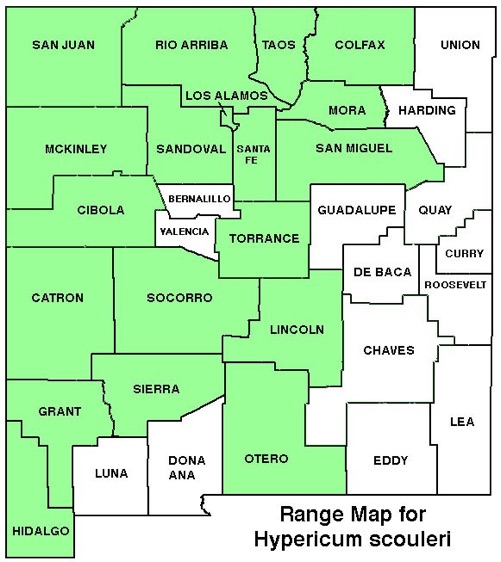WILDFLOWERS OF NEW MEXICO

The roots of this 7–27-inch tall, slender plant spread in moist soil to create colonies in ditches, meadows, and stream banks. Look for clusters of showy yellow flowers with numerous stamens and erect stems with opposite leaves.
FLOWERS: June–August. Rounded clusters of flowers with 5 yellow petals 1/4–1/2-inch (6–15 mm) long and lined with tiny black dots; 75–100 showy yellow stamens radiate like a pin cushion.
LEAVES: Opposite. Blades without stems (sessile), 3/8–1 3/8-inches (1–3.5 cm) long, oval to elliptic, pointed or rounded tips. Note the glandular black dots, especially along the edges.
HABITAT: Damp clay, gravelly soils; stream sides, meadows, ponderosa to spruce-fir-aspen forests.
ELEVATION: 7,000–9,300 feet.
RANGE: Widespread in all states west of Rocky Mountains.
SIMILAR SPECIES: The distinctive flowers, opposite leaves lined with black dots, and moist mountainous habitat help identify this species. The introduced and invasive Common St. Johnswort, H. peroratum, a landscape plant, is bushy with narrow oblong leaves.
NM COUNTIES: Throughout NM mountains in mid- to high-elevation, moist habitats: Catron, Cibola, Colfax, Grant, Hidalgo, Lincoln, Los Alamos, McKinley, Mora, Otero, Rio Arriba, San Juan, San Miguel, Santa Fe, Sandoval, Sierra, Socorro, Taos, Torrance.









ST. JOHNSWORT
HYPERICUM SCOULERI
St. Johnswort Family, Hypericaceae (Clusiaceae)
Perennial herb
THE CONTENTS OF THIS WEBSITE ARE COPYRIGHTED AND CANNOT BE USED
WITHOUT PERMISSION OF GEORGE OXFORD MILLER












































Black dots line the edges of the yellow petals (above) and leaves (below).



















EMAIL ME







